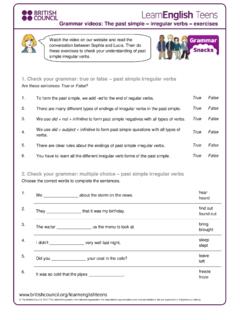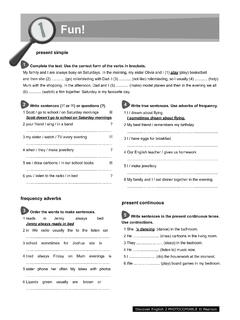Transcription of LANGUAGE FUNCTIONS and FORMS
1 LANGUAGE FUNCTIONS and FORMS . The English LANGUAGE Proficiency Standards are written as pathways to the Oregon English LANGUAGE Arts standards. The ELP. Standards are designed to supplement the ELA standards to ensure that LEP students develop proficiency in both the English LANGUAGE and the concepts and skills contained in the ELA standards. They can be found on the web at This section contains LANGUAGE FUNCTIONS and FORMS that native English speakers acquire mostly before entering school or naturally at home. These LANGUAGE FUNCTIONS and FORMS , however, need to be explicitly taught to English LANGUAGE learners (ELLs). They may be taught to ELLs at all grade levels, and as the need and context arises. FORMS of a LANGUAGE deal with the internal grammatical structure of words. The relationship between boy and boys, for example, and the relationship (irregular) between man and men would be FORMS of a LANGUAGE .
2 A LANGUAGE function refers to the purpose for which speech or writing is being used. In speech these include: giving instructions introducing ourselves making requests In academic writing we use a range of specific FUNCTIONS in order to communicate ideas clearly. These include: describing processes comparing or contrasting things or ideas, and classifying objects or ideas The contrast between form and function in LANGUAGE can be illustrated through a simple medical analogy. If doctors studied only a limited portion of the human system, such as anatomical form, they would be unable to adequately address their patient's needs. To fully treat their patients, physicians must understand the purposes of the human body and the relationships between organs, cells, and genes (Pozzi, 2004). Similarly, ELLs need to understand both the form (structure) and the function (purpose) of the English LANGUAGE in order to reach higher levels of proficiency.
3 Pozzi, (2004). FORMS and FUNCTIONS in LANGUAGE : Morphology, syntax. Retrieved March 10, 2005, from University of Houston, College of Education Web site: LANGUAGE FUNCTIONS and Examples of FORMS LANGUAGE Function Examples of LANGUAGE FORMS Expressing needs and likes Indirect/ direct object, subject/ verb agreement, pronouns Describing people, places, and things Nouns, pronouns, adjectives Describing spatial and temporal relations Prepositional phrases Describing actions Present progressive, adverbs Retelling/relating past events past tense verbs, perfect aspect (present and past ). Making predictions Verbs: future tense, conditional mode Asking Informational Questions Verbs and verb phrases in questions Asking Clarifying Questions Questions with increasing specificity Expressing and Supporting Opinions Sentence structure, modals (will, can, may, shall). Comparing Adjectives and conjunctions, comparatives, superlatives, adverbs Contrasting Comparative adjectives Summarizing Increasingly complex sentences with increasingly specific vocabulary Persuading Verb FORMS Literary Analysis Sentence structure, specific vocabulary Cause and Effect Verb FORMS Drawing Conclusions Comparative adjective Defining Nouns, pronouns, and adjectives Explaining Verb FORMS , declarative sentences, complex sentences, adverbs of manner Generalizing Abstract nouns, verb FORMS , nominalizations Evaluating Complex sentences; increasing specificity of nouns, verbs, and adjectives Interpreting LANGUAGE of propaganda, complex sentences, nominalizations Sequencing Adverbs of time, relative clauses, subordinate conjunctions Hypothesizing and speculating Modals (would, could, might), compound tenses (would have been).
4 ACQUISITION OF LANGUAGE FUNCTIONS AND GRAMMATICAL FORMS . ALL GRADES. 1. LANGUAGE Function: Expressing Needs and Likes BEGINNING EARLY INTERMEDIATE EARLY ADVANCED ADVANCED TARGET. INTERMEDIATE FORMS : Students demonstrate minimal Students demonstrate Students demonstrate good Students demonstrate Students' comprehension comprehension of general increased comprehension comprehension of general consistent comprehension of general and implied meaning; gain familiarity with the of general meaning and meaning; increased of general meaning; good meaning, including sounds, rhythms and patterns of some specific meaning; use comprehension of specific understanding of implied idiomatic and figurative English. Early stages show no routine expressions meaning; responds in more meaning; sustain LANGUAGE . Students verbal responses while in later independently and respond complex sentences, with conversation, respond with initiate and negotiate stages one or two word responses using phrases and simple more detail using newly detail in compound and using appropriate are expected.
5 Students respond in sentences, which include a acquired vocabulary to complex sentences; discourse, varied single words and phrases, which subject and predicate. experiment and form actively participate using grammatical structures may include subject or a predicate. Students show basic errors messages. (The brown more extensive vocabulary, and vocabulary; use of Many speech errors are observed. in speech. (The bear is bear lived with his family use standard grammar with conventions for formal (bear, brown) brown. He is eating.) in the forest.) few random errors. (Can and informal use. bears live in the forest if (Would you like me to they find food there?) bring pictures of the bear that I saw last summer?). One or two-word answers (nouns simple sentences with Elaborated sentences with Sentences with Complex sentences, Sentence Structure: or yes/no) to questions about subject/verb/object.
6 I subject/verb/object subject/verb/object and perhaps with tags or The basic sentence preferences, ( , two, apples, or like/don't like (object) dependent clause embedded questions structures that we use tree) . I need a /some to express needs and (object) . likes are foundations to the more complex sentence structure we use for academic purposes. 4. 2. LANGUAGE Function: Describing People, Places and Things BEGINNING EARLY INTERMEDIATE EARLY ADVANCED ADVANCED TARGET FORMS . INTERMEDIATE. Common nouns and adjectives simple sentences with the Elaborated sentences Compound sentences with Complex sentences with Nouns Pronouns and verb to be, using common has/have/had or more specific vocabulary more specific vocabulary Adjectives: Students nouns and adjectives. The is/are/were with nouns (nouns, adjectives) (nouns, adjectives) learn to understand and (my, her) _____ is/are and adjectives generate oral and written _____.
7 A (it) has/have LANGUAGE with nouns, _____. pronouns and adjectives. 3. LANGUAGE Function: Describing Location BEGINNING EARLY INTERMEDIATE EARLY ADVANCED ADVANCED TARGET FORMS . INTERMEDIATE. Demonstrated comprehension of simple sentences with May include two Complex sentences with Complex sentences with Prepositional Phrases: total physical response prepositional phrases prepositional phrases with phrases using prepositions phrases using prepositions Students learn to commands, including prepositions ( , next to, beside, more difficult ( , beneath, within) ( , beneath, within) understand and generate ( , on, off, in, out, inside, between, in front of, in prepositions ( , in front oral and written outside) back of, behind, on the of, behind, next to) LANGUAGE with left/right, in the middle of, prepositional phrases. above, below, under). 4. LANGUAGE Function: Describing Action BEGINNING EARLY INTERMEDIATE EARLY ADVANCED ADVANCED TARGET FORMS .
8 INTERMEDIATE. Demonstrate comprehension Present progressive Variety of verb tenses and Adverb clauses telling Adverb clauses telling Present Progressive, (perform or describe actions) descriptive adverbs how, where, or when how, where, or when. Adverbs: Students learn to understand and generate oral and written LANGUAGE skills with present progressive and adverbs. 5. LANGUAGE Function: Retelling/Relating past Events (Kinder General Understanding BEGINNING EARLY INTERMEDIATE EARLY ADVANCED ADVANCED TARGET FORMS . INTERMEDIATE. Single words in response to past simple sentences with simple sentences with Compound sentences Present progressive/ past past Tense Verbs: tense question past progressive __ regular and irregular past using past tense and perfect tense with Students learn to (pronoun) ___ was/were tense verbs adverb specialized prepositions understand and generate _____-ing.)
9 Yesterday/Last ____/On _____ have/has been oral and written ___day (pronoun) ____ - ____-ing since/for ____. LANGUAGE with past tense 5. ed (prep. phrase or other verbs. direct object). First ___. and then __ . Finally 6. LANGUAGE Function: Making Predictions BEGINNING EARLY INTERMEDIATE EARLY ADVANCED ADVANCED TARGET FORMS . INTERMEDIATE. In response to questions, may The _____ is/are going to The _____ will Conditional (could, might) Conditional (could, Verbs: Future Tense, respond by circling, pointing, and _____. _____. mood in complex might) mood in complex Conditional Mood: so on, or answer with one or two sentences sentences Students learn to words understand and generate oral and written LANGUAGE with future tense verbs and conditional mood. 7. LANGUAGE Function: Asking Informal Questions BEGINNING EARLY INTERMEDIATE EARLY ADVANCED ADVANCED TARGET FORMS . INTERMEDIATE.
10 simple questions about familiar Present or present Who, what, where, why Detailed questions with Detailed questions with Verbs and Verb Phrases or concrete subjects progressive tense questions with do or did who, what, when, where, expanded verb phrase in Questions: Students questions with to be why and how learn to understand and generate oral and written LANGUAGE with verbs and verb phrases in questions. 8. LANGUAGE Function: Asking Clarifying Questions BEGINNING EARLY INTERMEDIATE EARLY ADVANCED ADVANCED TARGET FORMS . INTERMEDIATE. Not Applicable Formula questions Formula questions A variety of fairly specific Varied, specific questions Questions with clarifying classroom clarifying classroom questions clarifying clarifying procedures or Increasing Specificity procedures, rules and procedures, rules and procedures or content content routines routines 9. LANGUAGE Function: Expressing and Supporting Opinions BEGINNING EARLY INTERMEDIATE EARLY ADVANCED ADVANCED TARGET FORMS .





